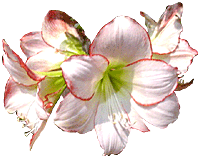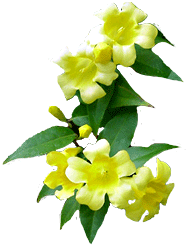
Candida Martinelli's Italophile Site

Main
Page This family-friendly site celebrates Italian culture for the enjoyment of children and
adults. Site-Overview
Victorian
Bazaar has a list of meanings in English
The illustrator Kate Greenaway provided the delicate images for a
Language of Flowers dictionary that you can now view on-line
thanks to the wonderful Project Gutenberg.
Kate
Greenaway's Language of Flowers On-Line
You can download a PDF version made from a scan of the book from
the, also wonderful, Internet Archive. You have to have a free
membership to download the book. It is WELL worth the small
effort. The Archive is a great source for bibliophiles.
Kate
Greenaway's Language of Flowers Page Here
are some beautiful books on the Language of Flowers from Amazon.com.
Mrs. Radcliffe's A Sicilian Romance
with a link to a
free PDF copy
But it was only in the Victorian era that these meanings were
collected together and codified for use in bouquets for secret floral
messages between lovers. So in the mid 1800s, when someone created a
bouquet, they created a message too.
The message wasn’t written in a letter or on a card, but in
the arrangement of flowers and foliage that made up the bouquet. For the educated at that time,
flowers and foliage had assigned meanings.
So the combinations used to make bouquets conveyed messages, to
be read only by others in-the-know. The mythical origins of the
language explains that they came from Turkey where a French painter
wooed a Harem girl. He
took her back to France as his wife where she taught European women to
speak with flowers and foliage to their lovers.
The Europeans then taught everyone else.
Some plant meanings are
obvious, like the Venus’ Fly-Trap signifying deceit and
danger.
Ouch! And a Lemon
Branch meaning zest or vigor. Zing! Some meanings are obvious if
you know the Latin name for the flower, like the Daffodil.
In Latin it’s called a Narcissus, named for the vain god.
The Daffodil signifies egotism. The more interesting are the
counter-intuitive ones, like a Cactus symbolizing warmth.
But if you think about it, the Cactus grows in a warm climate.
The prickliness is ignored. It’s interesting to note
that some meanings are different than meanings we commonly accept
today, such as for the Shamrock.
It does not symbolize luck, but instead means lightheartedness. And the holiday-season
favorite, Mistletoe, does not mean a kiss, but instead means ‘I
surmount difficulties’. Perhaps
the difficulty surmounted is how to get a certain person to let you
kiss them, or how to get a certain person to kiss you? Just a
thought… And in some countries, for Remembrance
Day, a day to honor the fallen in war, people wear Red Poppies.
But it's Rosemary that signifies remembrance. The Red Poppy
signifies condolence. So the Red Poppy wearing show condolences
for those the dead left behind, not remembrance of the war dead
themselves. One plant meaning is still
commonly known. The Olive
Branch is the universal symbol of peace.
And you do still hear people say someone is as solid as an Oak. The Oak symbolizes bravery.
While the language of flowers
and foliage is a dead language today, the dictionaries for this
language still exist and inspire the more romantic, or devious, among
us. If that includes you, here are some suggestions. A
bride’s bouquet of Blue Violets and Forget-Me-Nots surrounded by
Ivy promises a faithful and true love within marriage. A
Cabbage Rose and Lupines sent ahead by a date means the person
will arrive as an ambassador of love, voracious for your company. You
could head off the ambassador with a bouquet of Orange Blossoms
and Acacia Leaves declaring your chastity (with them) and offering
friendship instead. If
you receive Variegated Tulips with Peonies it could be you have an
admirer of your beautiful eyes who’s too bashful to tell you in
person. Watch
out for an Oleander Branch with Lavender around a Tuberose.
Someone could be trying to tell you to beware and to
distrust dangerous pleasures. But
Hollyhock with Sweet-Peas means someone has ambitions for delicate
pleasures. A
sweet arrangement is Buttercups with Daisies and Magnolia,
communicating a childish, innocent, love of nature. Even
sweeter is Honeysuckle, meaning generous and devoted affection. At
a time of loss, Pansies with either Red Poppies, Marigolds or Pine
Branches tell a person of your thoughts for them of consolation,
despair and pity. But
if the person mourning responds with Mimosa and Elm branches,
they’re telling you they’re still sensitive yet coping with
dignity. Decorating
your doorway with Oak Branches would signify your hospitality to
your party guests as they arrive. And
a gift bouquet for your party host of Sweet Basil, Parsley, Mint,
and Sage will not only make the food more flavorful, but also send
good wishes for the festivity, and praises the host for their
virtue, especially their domestic virtues. The
earthy combination of Grass and Wheat stocks means there’s to be
a submission with an expectation of great riches. But
for the broken heart, try sending the heart-breaker some Lettuce
Leaves with Hydrangeas and one White Rose Bud.
If they understand the language of flowers and foliage,
they’ll know you consider them a cold-hearted, boaster who’s
heart is ignorant of love.
I’ll leave you with an Oak
leaf with an Olive Branch, or the wish that you’re brave enough
to
seek peace where you now have strife.

The
Language of Flowers and Foliage - A Victorian tradition that has it's
roots in antiquity
![]()

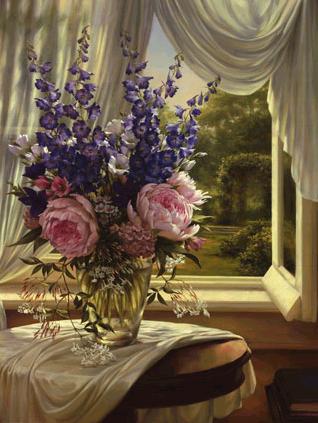
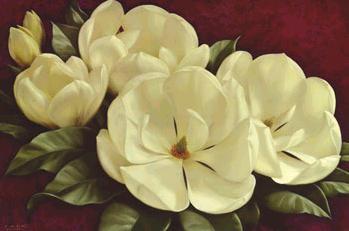


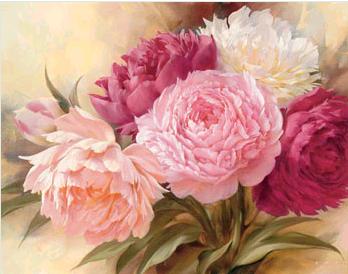

Ancient Roman texts mention
medicinal herbs and flowers. And the Latin names for flowers,
trees and herbs often signified either their use or a meaning
associated with the plant.

